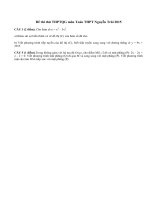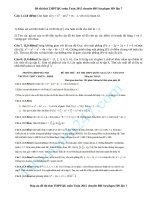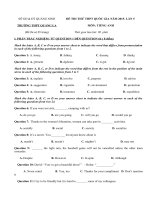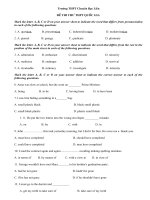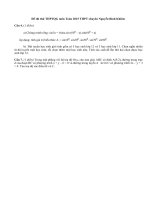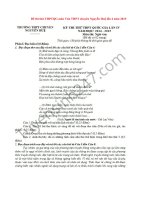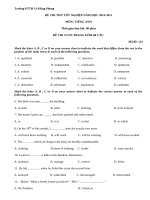Đáp án đề thi thử THPTQG môn Anh 2015 THPT chuyên Thái Nguyên
Bạn đang xem bản rút gọn của tài liệu. Xem và tải ngay bản đầy đủ của tài liệu tại đây (143.26 KB, 11 trang )
SỞ GD&ĐT THÁI NGUYÊN
ĐỀ THI THỬ THPT QUỐC GIA LẦN 3 NĂM 2015
TRƯỜNG THPT CHUYÊN
(Đề thi gồm 06 trang )
MÔN THI TIẾNG ANH - KHỐI D, A1
Thời gian: 90 phút ( không kể thời gian giao đề)
(Thí sinh làm bài ra phần phiếu trả lời trắc nghiệm)
Mã đề 175
Read the following passage and mark the letter A, B, C, or D on your answer sheet to indicate the
correct word or phrase that best fits each of the numbered blanks.
There can be no (1)...........at all that the internet has made a huge difference to our lives. Parents are
worried that children spend too much time playing on the internet, hardly (2).......... doing anything else in
their spare time. Naturally, parents are curious to find out why the internet is so attractive, and they want
to know if it can be harmful to their children. (3)........... parents worry if their children are spending that
much
time
staring
at
their
computer?
Obviously, if children are bent over their computers for hours, (4)............in some game, instead of
doing their homework, then something is wrong. Parents and children could decide how much use the
child should (5). ..........of the internet, and the child should give his or her word that it won't interfere
(6)............homework. If the child is not holding to this arrangement, the parents can take more drastic
(7)............. Dealing with a child's use of the Internet is not much different from negotiating any other sort
of
bargain
about
behaviour.
Any parent who is (8)..........alarmed about a child's behavior should make an appointment
to(9)................the matter with a teacher. Spending time in front of the screen does not necessarily affect a
child's at school. Even if a child is absolutely crazy about using the internet, he or she is probably
(10) ............ through a phase, and in a few months there will be something else to worry
Question l. A. doubt
Question 2. A. always
Question 3. A. Would
Question 4. A. supposed
Question 5. A. do
create
Question 6. A. of
from
Question 7. A. rules
Question 8. A. widely
Question 9. A. speak
debate
Question 10. A. going
B. reason
B. rarely
B. Could
B. occupied
B. have
C. purpose
C. never
C. Should
C. obsessed
C. make
B. on
B. regulations
B. heavily
B. discuss
B. passing
D. motive
D. ever
D. Did
D. absorbed
D.
C. with
C. methods
C. seriously
C. talk
C. walking
D.
D. steps
D. broadly
D.
D. traveling
Read the following passage and mark the letter A, B, C, or D on your answer sheet to
indicate the correct answer to each of the questions.
In most discussions of cultural diversity, attention has focused on
visible, explicit aspects of culture, such language, dress, food, religion, music,
and social rituals. Although they are important, these visible expressions of
culture, which are taught deliberately and learned consciously, are only the tip of
the iceberg or culture. Much of culture is taught and learned implicitly, or outside
awareness. Thus, neither cultural insiders nor cultural outsiders are aware that
certain "invisible" aspects of their culture exist.
Invisible elements of culture are important to us. For example, how long
we can be late before being impolite, what topics we should avoid in a conversation,
how we show interest or attention through listening behavior, what we consider
beautiful or ugly. These are all aspects of culture that we learn and use without
being aware of it. When we meet other people whose invisible cultural assumptions
differ from those we have learned implicitly, we usually do not recognize their
behavior as cultural in origin.
Differences in invisible culture can cause problems in cross-cultural
relations. Conflicts may arise when we are unable to recognize others’ behavioral
differences as cultural rather than personal. We tend to misinterpret other people's
behavior, blame them, or judge their intentions or competence without realizing that
we are experiencing cultural rather than individual differences.
Formal organizations and institutions, such as schools, hospitals,
workplaces, governments, and the legal system are collection sites for invisible
cultural differences. If the differences were more visible, we might have less
misunderstanding. For example, if we met a man in a courthouse who was wearing
exotic clothes, speaking a language other than ours, and carrying food that looked
strange, we would not assume that we understood his thoughts and feelings or that he
understood ours. Yet when such a man is dressed similarly to us, speaks our
language, and does not differ from us in other obvious ways, we may fail to
recognize the invisible cultural differences between us. As a result, mutual
misunderstanding may arise.
Question 11. What is the main purpose of the passage?
A. To explain the importance of invisible aspects of culture
B. To describe cultural diversity.
C. To point out that much of culture is learned consciously.
D. To explain why cross-cultural conflict occurs.
Question 12. The word "deliberately" in bold in paragraph I is Closest in meaning
to ________
A. slowly
B. accurately
C. intentionally
D. randomly
Question 13. The phrase "the tip of the iceberg" in bold in paragraph 1 means
that ________
A. other cultures seem cold to us
B. visible aspects of culture are learned in institutions
C. we usually focus on the highest forms of culture
D. most cannot be seen
Question 14. Which or the following was NOT mentioned as an example of invisible
culture?
A. What topics to avoid in conversation
B, What food to eat in a courthouse
C. How late is considered impolite
D. How people express interest in what others are saying
Question 15. The word "those" in bold in 2 refers to________
A. people from a different culture
B. invisible assumptions
C. people who speak a different language
D. topics that should be avoided
Question 16. It can be inferred paragraph 3 that conflict results when_______
A. people think cultural differences are personal
B. people compete with those from other cultures
C. one culture is more invisible than another culture
D. some people recognize more cultural differences than others
Question 17. According to the passage, which of the following is NOT true?
A. We are often aware that we are learning about culture
B. Visible aspects of cultures receive much attention in discussion of cultural
diversity
C. People misinterpret other people's behavior because they know they are
experiencing cultural differences
D. Invisible cultural differences are often witnessed at formal organizations
and institutions
Question 18. The author implies that institutions such as school and workplaces
________
A. are aware of cultural differences
B. teach their employees about cultural differences
C. reinforce invisible cultural differences
D. Share a common culture
Question 19. The “exotic” in bold in paragraph 4 is closest in meaning to _______
A. colourful
B. strange
C. familiar
D beautiful
Question 20. Which of the following would most likely result in misunderstanding?
A. Learning culture about our own culture in school
B. Unusual food being cooked by foreign visitors
C. Strange behavior from someone speaking a foreign language
D. Strange behavior from someone speaking our language
( ID: 105323 ) Mark the letter A, B, C, or D on answer sheet to indicate the word
whose underlined part differs from the other three in pronunciation in each of the
following questions.
Question 21. A. washed
Question 22. A. adventure
B. worked
B. mature
C. corrected
C. figure
D. crossed
D. procedure
Mark the letter A, B, C, or D on answer sheet to indicate the word or phrase that
is CLOSEST in meaning to the underlined part in each of the following questions.
Question 23. City developed at the point where the Hudson and Passaic rivers mingle
with the water of the Atlantic Ocean.
A. associate
B. socialize
C. mix
D. part
Question 24. Lack of water and nutrients has impeded the growth of these cherry
tomato plants.
A. promoted
B. assisted
C. realized
D. prevented
Question 25. Bone and ivory are light, strong and accessible materials for Inuit
artists.
A. available
B. beautiful
C. economic
D. natural
( ID: 105330 ) Mark the letter A, B, C, D on your answer sheet to indicate the
answer to each of the following questions.
Question 26: The Greens never stay at home at weekends, _______?
A. do they
B. does he
C. don 't they
D. doesn’t
he
Question 27 : ________are a form of carbon has been since the late eighteenth
century.
A. Diamonds, which
B. That diamonds
C. Because diamonds
D. Diamonds
Question 28. We regret _______ you that you have been made redundant
A. inform
B. to inform
C. informed
D.
informing
Question 29. The pollution problems in town have been _______by mass in the
summer.
A. exacerbated
B. developed
C. augmented
D.
contributed
Question 30: One of the tenets of New Criticism is that a critic need not tell
readers ________ about a story.
A. which thinking
B. What to think
C. that thinking
D. to
think what
Question 31: As neither of us would ________ , the bargain come to nothing.
A. give off
B. give out
C. give
away
D. give in
Question 32: David: “Would you like to join our volunteer group in this summer?”
Peter: “________”
A. Yes, I’d love to. Thanks.
B. I wouldn’t. Thank you.
C. Do you think I would?
D. Yes, you're a good friend.
Question 33: Such _______that the firelighters could not get near it.
A. the fire was hot
B. hot was
the fire
C. was the heat of the fire
D. the hot fire
Question 34: It is just as well you didn't put your money in that company,
because it would have been an absolute________ if you had.
A. mistake
B. catastrophe
C.
error
D. miscalculation
Question 35: _______ little we may like it, old age comes to most of us
A. However
B. Despite
C. So
D. Since
Question 36: Down _______ for three days.
A. the rain poured
B. poured the rain
C. did the rain pour
D. the
rain pour
Question 37: She got so _______while watching the match on TV that she began
shouting.
A. excited
B. excitement
C.
exciting
D. excitedly
Question 38: Having made his first film earlier this year, he is _______ starring
in a musical.
A. lately
B. currently
C.
recently
D. actually
Question 39: She was unemployed three years ago, I don't know _______she is living
on nowaday.
A.How
B. Why
C.
what
D. where
Question 40: When ________ is not known.
A. it was invented the wheel
B. was the wheel
invented
C the invention or the wheel
D. the wheel was
invented
Question 41: When a fire broke out in the Louvre ,at least twenty ________
paintings were destroyed, including two by Picasso.
A. priceless
B. valueless
C. worthless
D. worthy
Question 42: Mai: “Wow, I’ve never seen such a nice cell phone, Nam” - Nam:
“_____”.
A. Oh, I don’t know.
you like it.
C. You’re welcome.
B. Thank you. I’m glad
D. I agree with you.
Question 43: Nowadays children would prefer history _______in more practical ways.
A. to teach
B. teach
C.
taught
D. to be taught
Question 44: Do you think you ______that report by the end of the week?
A. have finished
B. Will be finishing
C. Will have finished
D. finished
Mark the letter A, B, C, or D on your answer sheet to indicate the word that
differs from the rest in the position of main stress in each of the following
questions.
Question 45. A. weather
entrance
Question 46. A. dependence
compliment
Question 47. A. applicant
performance
B. confirm
B. prediction
B. ambitious
C. highland
D.
C. disastrous
D.
C. essential
D.
Mark A, B, C or D on your answer sheet to indicate the underline part that needs
correcting
Question 48. The number of wild condors, an endangered species of (A) bird, have
been(B) increasing steadily(C) because of (D) the work scientists and
environmentalists.
Question 49. Children’s games(A), which are amusements involve(B) more than one
individual, appear to be(C) a cultural universal (D)
Question 50. Woody Gutlvrie wrote thousands of songs (A) during his lifetime(B),
many of whom(C) became classic folk(D) songs.
Question 51. If you caught driving(A) without a licence(B), you risk to be(C)
heavily fined(D)
Question 52. Tree squirrels are active, noisy(A), and lively(B) animals that(C)
make its(D) home in trunks
Read the following passage mark letter A, B, C, or D on your sheet to indicate the
correct answer to each of the questions
Coincident with concerns about the accelerating loss of species and
habitats has been a growing appreciation of the importance of biological diversity,
the number of species in a particular ecosystem, to the health of the Earth and
human well-being. Much has been written about the diversity of terrestrial
organisms, particularly the exceptionally rich life associated tropical rain-forest
habitats. Relatively little has been said, however, about diversity of life in the
sea even though coral reef systems are comparable to rain forests in terms of
richness of life.
An alien exploring Earth would probably give priority to the planet's
dominants - most distinctive feature - the ocean. Humans have a bias toward land
that sometimes get in the way of truly examining global issues. Seen from far away,
it is easy to realize landmasses occupy only one-third of the Earth’s surface. Given
that two thirds of the Earth's surface is water and that marine life lives at all
levels of the ocean, the total three-dimensional living space of the ocean is
perhaps 100 times greater than that of land and contains more than 90 percent of all
life on Earth even though the ocean has fewer distinct species.
The fact that half of the known species are thought to inhabit the
world's rain forests doesn't seem surprising, considering the huge numbers of
insects that comprise the bulk of the species. One scientist found many different
species of ants in just one tree from a rain forest. While every species is
different from every other species, their genetic makeup constrains them to be
insects and to share similar characteristics with 750,000 species of insects. If
basic, broad categories such as phyla and classes are given more emphasis than
differentiating between species, then the greatest diversity of life is
unquestionably by sea. Nearly every major type of plant and animal has some
presentation there.
To appreciate fully the diversity and abundance of life in the sea, it helps to
think small. Every spoonful of ocean water life, on the order of 100 to 100,000
bacteria cells plus assorted microscopic plants and animals, including larvae of
organisms ranging from sponges and corals to starfish and clams and much more.
Question
A.
53. What
Humans
is
are
the
main
destroying
point
of
thousands
the
of
passage?
species
B.
There
are
C.
The
sea
is
even
D. Coral reefs are similar to rain forests
thousands
richer
in
of
life
than
insects
the
rain
species
forests
Question 54. The word "appreciation" in paragraph 1 is closest in meaning to______
A. ignorance
B. recognition
C. tolerance
D. forgiveness
Question 55. Why does the author compare rain forests and coral reefs in paragraph 1?
A.
They
are
approximately
the
same
size
B.
They
share
many
similar
species
C.
Most
of
their
habitats
require
water
D.
Both
have
many
different
forms
of
life
Question
56. The
"bias"
in
2
is
closet
in
meaning
to________
A.concern
B.
disadvantage
C.
attitude
D.
prejudice
Question 57. Which of the following is true about the ocean to the passage?
A.
It's
100
limes
greater
than
land
B.
It
contains
more
species
than
land
C.
It
contains
a
vast
majority
of
life
on
Earth
D.
It
occupies
one-third
of
the
Earth'
surface
Question 58. The passage suggests that most rain forests species are_______
A.insects
B.
bacteria
C.
mammals
D.
birds
Question
59. The
word
"there"
in
paragraph
3
refers
to
_______
A.the sea
B. the rain forests
C. a tree
D. the Earth’s surface
Question 60. The author argues that there is more diversity of life than in the rain forests because
A.
more
phyla
and
classes
of
life
are
presented
in
the
sea
B.
there
are
too
many
insects
to
make
meaningful
distinctions
C. many insect species too small to divide into categories
D.
marine
life-form
reproduce
at
a
faster
rate
Question 61. Which of the following is NOT mentioned as an example of microscopic sea life?
A.
Sponges
B.
Coral
C.
Starfish
D.
Shrimp
Question 62. Which of the following conclusions is supported by the passage?
A.Ocean
life
is
highly
adaptive
B. More attention needs to be paid to preserving ocean species and habitats
C.
Ocean
life
is
primarily
composed
of
plants
D. The sea is highly resistant to the damage done by pollutants
Mark the letter A, B, C, or D on your answer sheet to indicate the word or phrase that is OPPOSITE
in meaning to the underlined part in each of the following questions.
Question 63. Their migration may be postponed if fog, clouds or rain hides the star.
A.cancelled
B.
continued
C.
spoiled
D.
damaged
Question 64. Even when textbooks are standardized throughout a school system, methods of teaching
with
may
be
greatly
varied.
A. different
B. made the same
C. expensive
D. lacking
WRITING
Part l. Finish each of the following sentences in such a way that it means the same as the sentence
printed before it.
Question
Question
65. As
The
66. "You
he
grew
older,
he
became
more
forgetful
.....................................................................................................................
really
must
stay
with
us
this
weekend!"
Laura
said,
Laura
insisted......................................................................................................
Question 67. He couldn't come to the party because of his serious illness.
Had
he.................................................................................................................
Question 68. The writer's writing style contrasted sharply with his spoken language.
There
...................................................................................................................
Question 69. The financial crisis affects both developed and third-world countries.
Not only .............................................................................................................
Part ll. In about 140, write a paragraph about the advantages of reading books.
Đáp án đề thi thử THPT Quốc gia môn Anh 2015 THPT chuyên Thái Nguyên lần 3
1. Đáp án là A. no doubt: không còn nghi ngờ gì nữa, chắc chắn
Các từ còn lại: reason: lý do; purpose: mục đích; motive: lý do
2. Đáp án là D. hardly ever: hiếm khi = seldom
Các từ còn lại: always: luôn luôn;
rarely: hiếm khi; never:không bao giờ
3. Đáp án là B. Could : có thể ( chỉ khả năng )
Các từ còn lại: Would: sẽ, Should: nên;
4. Đáp án là D. absorbed: mải mê, chăm chú
Các từ còn lại: supposed: được cho là, tưở
ở ng là ; occupied: bận rộn; obsessed: ám
ảnh
5. Đáp án là C. make use of: tận dụng, lợi dụng …. Trong bài này, use được chuyển
lên sau “how much”
6. Đáp án là C. interfere with: gây cản trở
7. Đáp án là D. take drastic steps: thực hiện các bước quyết liệt
8. Đáp án là C. seriously:không đùa, thật sự, nghiêm trọng,..
Các từ còn lại:
widely: một cách rộng rãi; heavily : nặng; broadly: rộng rãi
9. Đáp án là B. discuss something: thảo luận cái gì
Các động từ khác cầầ
n có giới từ theo sau. Speak to; talk to/about; debate: suy nghĩ
cân nhắc
10. Đáp án là A. go through: xem xét tỉ mỉ, kỹ lưỡng
11. Đáp án là A. Có thể dựa vào những câu đầu đoạn:
- Invisible elements of culture are important to us.
- Differences in invisible culture can cause problems in cross-cultural relations.
12. Đáp án là C. deliberately: có tính toán, suy nghĩ thận trọng = intentionally
Các từ còn lại: slowly: một cách chậm chạp; accurately: một cách chính xác;
randomly: một cách ngầẫ
u nhiên
13. Đáp án là D. Chú ý đến từ chỉ sự tương phản “although – mặc dù” đầu câu và cụm
these visible ( hữu hình ) expressions of culture, …., are only the tip of the
iceberg or culture
14. Đáp án là B.
A, C, D được đề cập: how long we can be late before being impolite, what topics we
should avoid in a conversation, how we show interest or attention through listening
behavior, ….
15. Đáp án là B. those = invisible assumptions . Ta thấy cùng trong một câu so sánh
không ngang bằng : When we meet other people whose invisible cultural assumptions
differ from those we have learned implicitly….
16. Đáp án là A. Ý trong bài: Conflicts may arise when we are unable to recognize
others’ behavioral differences as cultural rather than personal.
17. Đáp án là C. Ý trong bài, từ mấu chốt là “ without” : We tend to misinterpret
other people's behavior, blame them, or judge their intentions or competence without
realizing that we are experiencing cultural rather than individual differences.
18. Đáp án là C. Ý trong bài: Formal organizations and institutions, such as
schools, hospitals, workplaces, governments, and the legal system are collection
sites for invisible cultural differences.
19. Đáp án là B. Exotic: kỳ lạ
= strange
Các từ còn lại: colorful: sặc sỡ; familiar: quen thuộc, beautiful: đẹp
20. Đáp án là D. Ý trong bài: speaking a language other than ours, and carrying food
that looked strange, we would not assume that we understood his thoughts and
feelings or that he understood ours. 21. Đáp án là C. Từ corrected có phần gạch chân
được phát âm là /id/, các từ còn lại có phần gạch chân được phát âm là /t/
22. Đáp án là B. Từ mature có phần gạch chân được phát âm là /juə/, các từ còn lại
có phần gạch chân được phát âm là /ə /
23. Đáp án là C. mingle = mix: trộn lẫn, lẫn vào
Các đáp còn lại: associate: kếế
t hợp, cộng tác; socialize: xã hội hóa; part: xa lìa,
chia tách
24. Đáp án là D. impede = prevente: ngăn cản
Các từ còn lại: promote: thúc đầở
y; assist: giúp đỡ; realize: nhận ra
25. Đáp án là A. accessible = available:
có thể sử dụng được
Các từ còn lại: beautiful: đẹp; economic: thuộc nếầ
n kinh tếế
; natural: thuộc tự nhiên
26. Đây là câu hỏi láy đuôi. “never” đã mang nghĩa phủ định => vế láy đuôi chia ở
khẳn định. => C và D loại
The Greens : gia đình Green, chỉ số nhiều => Đáp án là A.
27. Đáp án là B. Ta thấy câu có hai động từ “are” và
“has been” => C và D loại
A cũng loại , về hình thức thiếu dấu phẩy sau “carbon”
=> Đáp án là B. That + S + V – mệnh đề danh từ, đóng vai trò như một danh từ, có thể
đứng đầu câu làm chủ ngữ, và động từ theo sau chia ở dạng số ít.
28. Với động từ “regret” có hai cấu trúc:
Regret + V-ing: hối hận vì đã làm gì ; Regret + to V: rất lấy làm tiếc khi phải làm
….
=> Đáp án là B. Dịch: Chúng tôi rất lấy làm tiếc phải nói cho anh biết rằng anh đã
bị sa thải.
29. Câu này hỏi về nghĩa từ vựng. Đáp án là A. exacerbate: làm tăng, làm trầm trọng
Các từ còn lại: develop: phát triếở
n; augment: tăng lên ( nội động từ ); contribute:
phân phát
30.Đáp án là B. What
+ to V ( cái để làm ): đóng vai trò như danh từ
31. Đáp án là D. give in: nhượng bộ
Các từ còn lại: give out: chia, phân phốế
i; give off: tỏ
ởa ra, bốế
c ra; give away:
trao, phát
32. Would you like + to V? – Cấu trúc đề nghị gợi ý
Đáp án là A. Yes, I’d love to. Thanks. – Được, tôi thích. Cảm ơn - Chỉ sự đồng tình
Các đáp án còn lại:
B. Tôi sẽ không tham gia. Cám ởn bạn.
C. Bạn nghĩ tôi sẽ tham gia ư?
D. Ừ, bạn là một người bạn tốt.
33. Đáp án là C. Cấu trúc “quá … đến nỗi…” ở dạng đảo ngữ : Such + be + N + that +
S+ V.
34. Đáp án là B. catastrophe: tai ương, tai biến
Các từ còn lại: mistake : lốẫ
i; error: lốẫ
i; miscalculation: sự tính nhầầ
m
35. Đáp án là A. Cấu trúc chỉ sự tương phản với “however”: However +adj/adv + S + V,
S + V.
36. Đáp án là B. Với trạng ngữ chỉ nơi chốn đứng đầu câu, ta đảo động từ chính trước
chủ ngữ: Adv (place) + V+ S.
37. Đáp án là A. get + adj: trở nên như thế nào, với chủ ngữ “she” ta chọn tính từ
“excited”
38. Đáp án là B. currently: hiện nay
Các từ còn lại: lately: vào thời gian gầầ
n đây; recently : gầầ
n đây; actually: thực
sự, trên thực tếế
39. live on something: sống dựa vào …..
=> trường hợp này sẽ dùng what để thay thế cho something, đảo lên trước chủ ngữ
“she”.
Dịch: I don't know what she is living on nowaday. – Tôi không biết bây giờ cô ấy
sống bằng gì.
40. Đáp án là D, Động từ chính trong câu này là “is” ,when + S+ V cũng được coi là
mệnh đề danh ngữ, có thể đứng đầu câu làm chủ ngữ, và động từ theo sau ở dạng số ít.
41. Đáp án là A. priceless: vô giá, không định đoạt được bằng giá cả, rất giá trị.
Các từ còn lại: worthless: vô giá trị, vô dụng ; worthy: có giá, đáng giá; valueless: không có giá trị, vô
dụng
42. I’ve never seen such a nice cell phone – Tớ chưa bao giờ nhìn thấy chiếc điện thoại đẹp như vậy. =>
lời khen
=> Đáp án là B. Cám ơn. Tớ rất vui khi cậu thích nó.
Các đáp án khác không hợp ngữ cảnh:
A. Ồ. Tớ không biết.
C. Câu đáp lại lời cám ơn của ai đó.
D. Tớ đồng tình với cậu.
43. Đáp án là D. Cấu trúc bị động với prefer: prefer + something + to be done
44. Đáp án là C. By + mốc thời gian tương lai => thì tương lai hoàn thành
45. Đáp án là B. Từ comfirm trọng âm rơi âm tiết thứ hai, các từ còn lại trọng âm
rởi âm tiếế
t thứ nhầế
t
46. Đáp án là D. Từ compliment trọng âm rơi âm tiết thứ nhất, các từ còn lại trọng
âm rởi âm tiếế
t thứ hai
47. Đáp án là A. Từ applicant trọng âm rơi âm tiết thứ nhất, các từ còn lại trọng âm
rởi âm tiếế
t thứ hai
48. Đáp án là B. have been => has been. The number + Ns chỉ số lượng, động từ theo
sau chia ở dạng sốếít
49. Đáp án là B. involve => involving, rút gọn đại từ quan hệ
50. Đáp án là C. whom => which, thay thế cho “songs”
51. Đáp án là C. to be => being. Ta có : risk+ V-ing: liều lĩnh…
52. Đáp án là D. its => their,
tính từ sở hữu thay thếếcho “Tree squiwels”
53. Đáp án là C. Relatively little has been said, however, about diversity of life in the sea even though
coral reef systems are comparable to rain forests in terms of richness of life.
54. Đáp án là B. appreciation = recognition: sự thừa nhận, công nhận
Các đáp án còn lại: ignorance: sự lờ đi, tolerance : sự khoan dung; forgiveness: sự tha thứ
55. Đáp án là D. Dựa vào cụm từ “about diversity of life in the sea” , diversity of life = many different
forms of life
56. Đáp án là D. bias = prejudice: thành kiến
Các từ còn lại: concern: mối quan tâm; disadvantage : sự bất lợi; attitude: thái độ
57. Đáp án là C. Dựa vào chi tiết trong bài: Given that two thirds of the Earth's surface is water and that
marine life lives at all levels of the ocean, the total three-dimensional living space of the ocean is perhaps
100 times greater than that of land and contains more than 90 percent of all life on Earth even though the
ocean has fewer distinct species.
58. Đáp án là A. Ý trong bài: One scientist found many different species of ants ( kiến ) in just one tree
from a rain forest. While every species is different from every other species, their genetic makeup
constrains them to be insects and to share similar characteristics with 750,000 species of insects.
59. Đáp án là A. Ta thấy câu trước đó đề cập đến địa điểm “by sea” => “there” thay thế cho “the sea”
60. Đáp án là A. Ý trong bài: If basic, broad categories such as phyla and classes are given more emphasis
than differentiating between species, then the greatest diversity of life is unquestionably by sea.
61. Đáp án là D.
A, B, C được đề cập : including larvae of organisms ranging from sponges and corals
to starfish and clams and much more.
62. Đáp án là B. Đoạn văn đề cập sự đa dạng cách loài ở biển, được so sánh với các
loài ở rừng => nhằm mục đích khuyếế
n khích mọi người nên bao tốầ
n các loài ở đại dưởng
và môi trường sống của chúng
63. Đáp án là B. postponed: bị hoãn >< continued : được tiếp tục
Các từ còn lại: cancelled: bị hủy; spoiled: bị hư hỏng; damaged: bị phá hủy
64. Đáp án là A. standardized: được chuẩn hóa >< different: tách ra, khác rõ rệt
Các từ còn lại: made the same : làm giống; expensive: đắt; lacking : thiếu
WRITING
Part 1.
1.
The older he grew, the more forgetful he became
2.
Laura instead on my staying with them that weekend
3.
Had he not been seriously ill, he could have come to the party
4.
There was a sharp contrast between the writer’s writing style and his spoken
language
5.
Not only developed countries but also third-world countries are effected by
the financial
Part 2:
It is said that reading books is important in our life. Indeed, without reading, we
can have many troubles in the future. Firstly, book is an endless source of
knowledge. In fact, if you are a student, the teacher's explanations are not enough
for you .You should read books to understand the lessons better and do exercises
better. Not only students but also doctors, scientists, businessmen, etc need to
read more books. Secondly, books bring us joy and encouragements as a consoler .You
have once been in bad mood in your life, haven't you? Why don't you read humorous
stories which will make you happier. In conclusion, reading is the best way to get
access to living experiences.



